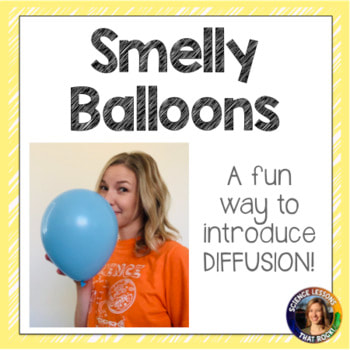Diffusion is a topic that is covered in biology (when we introduce cell membranes) and chemistry (particle movement and kinetic theory). I came across this “smelly balloons” activity on Flinn’s website and thought it was such a fun way to introduce diffusion. In this activity, students will smell balloons that have different flavor extracts inside. Their task is to guess the scent and explain particle movement. How is the smell passing through the latex barrier? (Note: Prior to this activity you will need to make sure none of your students have latex allergies. Bust out those lab safety contracts they signed at the beginning of the year!)
For this activity you will need:
– Balloons (an assortment of colors is ideal)
– Eyedroppers or pipettes
– A variety Flavor extracts* or different odor substances
– String and tape (optional)
*Flinn’s directions say to use a variety of flavor extracts. Flavor extracts can be pricey, so if you don’t have very many at home you have some other options. You can use essential oils, perfume, or cooking spices. I used vanilla extract, lemon extract, eucalyptus oil, and cinnamon (mixed with a little bit of water to make a slurry).
Directions:
- Collect different extracts you plan to use.
- Purchase balloons at the dollar store or a party store. If you plan to use 4 extracts, you will want 5 different colors of balloons (one extract per color, plus an empty balloon as a control).
- Using a clean eyedropper, place 3-4 mL of the first extract into the balloon. Rub the liquid around so the inside of the balloon is coated, and then blow up the balloon. I made 2 of each scent.
- Using a new eyedropper, place 3-4 mL of the next extract into a different colored balloon. Repeat this step until you have as many scents as desired.
- Blow up one colored balloon with no scent inside. Since latex balloons have their own odor, this will be used as a control.
- Optional: so students don’t play around with the balloons, tie a string to the end, and tape the string to the lab table. That way they won’t fly away.
- Have students rotate around the room smelling each balloon color. They will predict which scent extract is inside.
- When they have finished and return back to their desks, you can go over the correct answers and see how many they got right. As a class discuss: how did the scent pass through the balloon? You can introduce vocabulary words including: diffusion, semi-permeable membrane, concentration gradient, and equilibrium.
|
I made a worksheet to accompany the activity that you can download for free HERE.
Once you move on to osmosis, check out this easy onion skin lab I do every year! |








